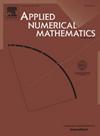Numerical method and analysis for fluid-structure model on unbounded domains
IF 2.4
2区 数学
Q1 MATHEMATICS, APPLIED
引用次数: 0
Abstract
Numerically solving the fluid-structure model on unbounded domains poses a challenge, due to the unbounded nature of the physical domain. To overcome this challenge, the artificial boundary method is specifically applied to numerically solve the fluid-structure model on unbounded domains, which can be used to analyze fluid-structure interactions in various scientific and engineering fields. Drawing inspiration from the artificial boundary method, we employ artificial boundaries to truncate the unbounded domain, subsequently designing the high order local artificial boundary conditions thereon based on the Padé approximation. Then, the initial value problem on the unbounded domain is reduced into an initial boundary value problem on the computational domain, which can be efficiently solved by adopting the finite difference method. Furthermore, a series of auxiliary variables is introduced specifically to address the issue of mixed derivatives arising in the artificial boundary conditions, and the stability, convergence and solvability of the reduced problem are rigorously analyzed. Numerical experiments are reported to demonstrate the effectiveness of artificial boundary conditions and theoretical analysis.
无界域流固模型的数值方法与分析
由于物理域的无界性,在无界域上对流固模型进行数值求解是一项挑战。为了克服这一挑战,专门采用人工边界法对无界域上的流固耦合模型进行数值求解,可用于各种科学和工程领域的流固耦合分析。受人工边界法的启发,我们采用人工边界截断无界域,然后基于pad近似在无界域上设计高阶局部人工边界条件。然后,将无界域上的初值问题转化为计算域上的初边值问题,采用有限差分法进行有效求解。此外,针对人工边界条件下的混合导数问题,引入了一系列辅助变量,并对简化后的问题的稳定性、收敛性和可解性进行了严格的分析。数值实验证明了人工边界条件和理论分析的有效性。
本文章由计算机程序翻译,如有差异,请以英文原文为准。
求助全文
约1分钟内获得全文
求助全文
来源期刊

Applied Numerical Mathematics
数学-应用数学
CiteScore
5.60
自引率
7.10%
发文量
225
审稿时长
7.2 months
期刊介绍:
The purpose of the journal is to provide a forum for the publication of high quality research and tutorial papers in computational mathematics. In addition to the traditional issues and problems in numerical analysis, the journal also publishes papers describing relevant applications in such fields as physics, fluid dynamics, engineering and other branches of applied science with a computational mathematics component. The journal strives to be flexible in the type of papers it publishes and their format. Equally desirable are:
(i) Full papers, which should be complete and relatively self-contained original contributions with an introduction that can be understood by the broad computational mathematics community. Both rigorous and heuristic styles are acceptable. Of particular interest are papers about new areas of research, in which other than strictly mathematical arguments may be important in establishing a basis for further developments.
(ii) Tutorial review papers, covering some of the important issues in Numerical Mathematics, Scientific Computing and their Applications. The journal will occasionally publish contributions which are larger than the usual format for regular papers.
(iii) Short notes, which present specific new results and techniques in a brief communication.
 求助内容:
求助内容: 应助结果提醒方式:
应助结果提醒方式:


